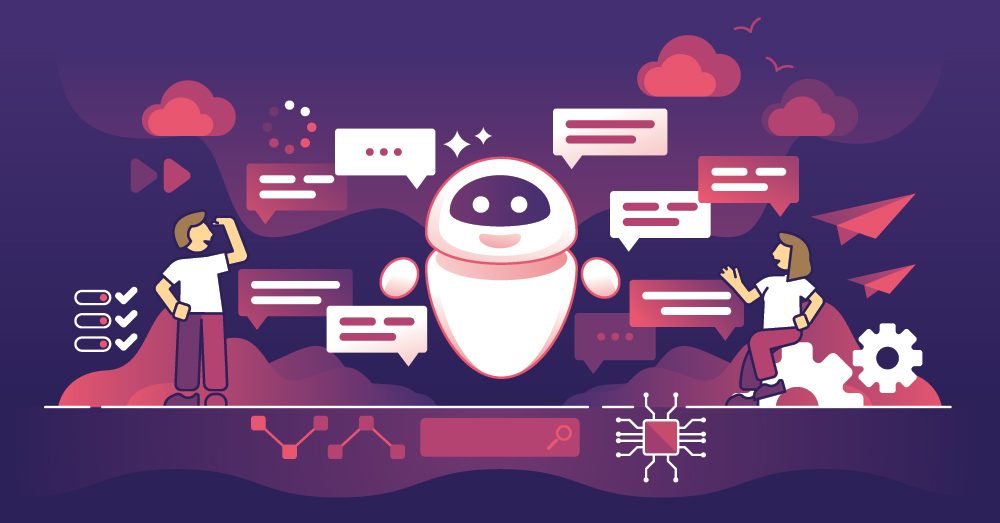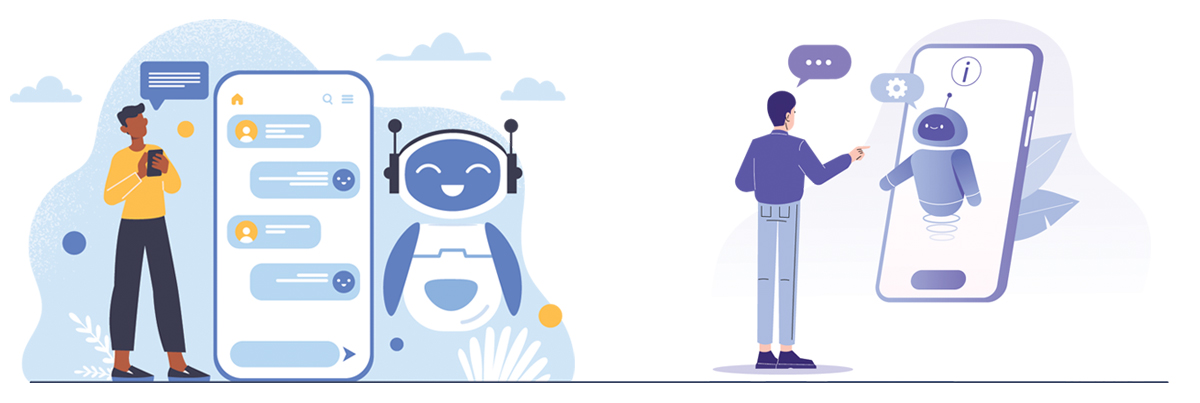
By Lauren Commander
Walk into Edward Duran's Information Systems Management classroom and you might find not just the professor but also digital avatars doing the talking. In these scenario-based learning lessons, Duran, assistant teaching professor of information systems and business analytics at FIU Business, and his students are witness to the rapidly evolving world of conversational artificial intelligence (AI) in education. "I have a fake executive – a talking avatar – explain a business problem, and my students engage with that talking avatar to discuss what we are covering in class in a new and unique way," Duran said. "The students find it entertaining and engaging. They pay attention."
Duran creates and animates avatars with a generative AI platform by uploading a script depicting the scenario; he writes the script with the help of ChatGPT. It is one of many ways conversational AI technologies are influencing Duran's job as an educator. "I've been using ChatGPT to create better examples in my lessons, AI to make better captions for my videos, and AI to crop ‘um' and ‘uh' out of my videos. I've expanded my skillset via augmentation with AI, and I feel a little superhuman."
If it seems as if there is something superhuman going on as workers across industries operate with conversational AI as their co-pilot, there is. Businesses particularly benefitting from this technology are those that rely on customer service. Not only can conversational AI tailor chats to individual users based on context, but it can also talk to millions of customers simultaneously, allowing for scalability and decimating dreaded wait times. Look no further than Bank of America's Erica, touted as a virtual financial assistant that can check your balance and offer financial advice, or Expedia's virtual assistant that responds to requests and makes travel plans.
The technology also is changing the ways businesses operate, facilitating globalization by eliminating language barriers and saving on labor costs, said Pouyan Esmaeil Zadeh, associate professor of information systems and business analytics at FIU Business.
"They collect data, analyze it and learn. They can self-train and understand, the next time someone asks it a question, how it can answer better."
- Pouyan Esmaeil Zadeh
In November, OpenAI released ChatGPT, which now has more than 100 million weekly active users. As people increasingly turn to conversational AI tools like chatbots and virtual assistants for help with tasks and recommendations, big tech companies continue to develop AI models like Google's Bard, Microsoft's Bing and Amazon's Q. "We've been getting into [an] exponential rate of improvement, with improved models coming out every few weeks," said Andres Arias (DBA '26, MSIS '21), chief product officer for Digital Communications Technologies (DCT), a developer of Internet of Things devices and accessories, and former senior product manager at Google.
In a nutshell, conversational AI enables computers to understand, process, analyze and respond to human language in a very natural, meaningful and engaging way. A decade ago, conversational AI centered on simple conversation. Today, large language models give chatbots and virtual assistants the ability to process complex tasks and, even more significantly, learn along the way through interactions and context.
"They collect data, analyze it and learn," Zadeh said. "They can self-train and understand, the next time someone asks it a question, how it can answer better."

At first, companies used tools like ChatGPT, but those systems rely on data available to anyone on the internet. Enter companies like Amazon Web Service (AWS), offering open-source models that can be fine-tuned with company-specific data sets that can be kept private. "AWS has democratized generative AI tools for $20 a month, with Amazon Q, [a] purpose-built GPT suite for business, with the data that runs Amazon.com," said Jon Sastre (MSIS '08, BBA '01), senior partner sales manager and certified solutions architect for AWS. "Customers rent an account, and we can't see their data but can give them the software tools and put that to work for them.
It's imperative for businesses to understand how these systems work and consider the privacy implications, experts agree.
"Every day, people enter personal information and sometimes sensitive health information into ChatGPT in hopes of getting answers," Zadeh said. "People don't realize how much data conversational AI is collecting from them, how it's stored and shared with other companies, and how it's analyzed."

Companies should be transparent with customers about how their data is being used, Duran said. "All those terms and conditions no one reads? It worries me that people might not understand that many AI systems rely heavily on your data to work, and companies don't want to be in a situation where their trust is lost because they didn't manage or communicate how they use customer data properly."
It's important for users to understand that the outputs of ChatGPT and related technologies are not always correct, and considerations should be made for human validation processes with the outputs of some of these technologies. Risk management departments need to consider what could go wrong and what to do when AI does not get it right, Duran noted.
The models also can be prone to bias because of bias in the training data, leading to discrimination or unfair treatment that needs to be addressed. Type "nurse" into Google and click on images, and you will see virtually all female nurses. A search for "technology professional" will populate images of men. "It's hard to overcome that," Sastre said.
People also can be easily defrauded. "The output you get from these tools is convincing, and I can see them being used to initiate phishing attacks," Zadeh said.
Cybersecurity threats have emerged as people put malicious prompts into a chatbot to make it spill data or say things it shouldn't. "The systems are trained and given rules and guardrails to do and not do certain things, but the internet is filled with people trying to break these rules for fun," Sastre said.
The future with this technology holds countless possibilities, from increased efficiency and scalability to new and quicker ways to use data. We will finally get personal assistants like Siri, Alexa and the like to answer queries with higher complexity as they keep getting smarter and smarter, with chatbots and voice systems replacing dashboards and reports, Arias said.
"The systems are trained and given rules and guardrails to do and not do certain things, but the internet is filled with people trying to break these rules for fun."
- Jon Sastre
"The biggest impact for the enterprise is that you can do more with less," he added. "One potential use case for generative AI is to have an assistant for business intelligence. We aim to create a digital experience that gives business leaders answers and insights using natural language as they need it."
Or even before they ask.
"You can put a voice to a chatbot, using tools like Amazon Lex," Sastre said. "It's something you can talk to that's almost like it's alive. It feels like magic. But in reality, it's not able to think – yet."
After a pause, he added, "It's not even close."